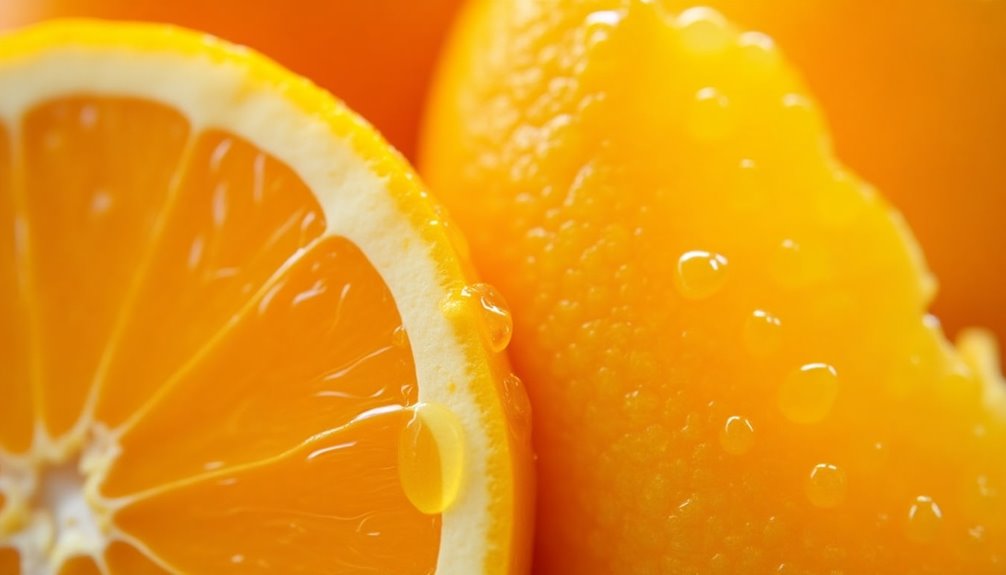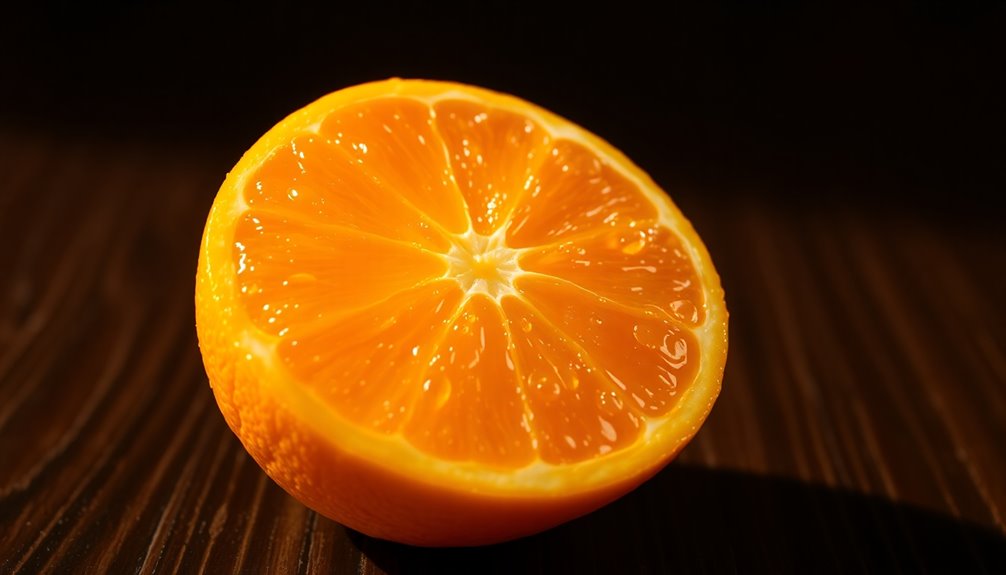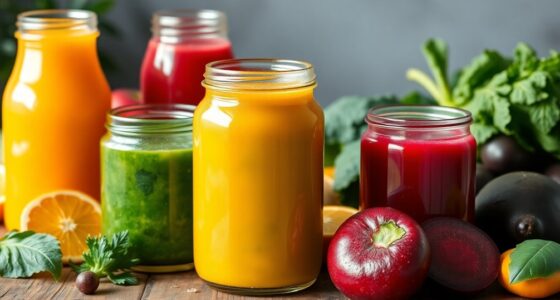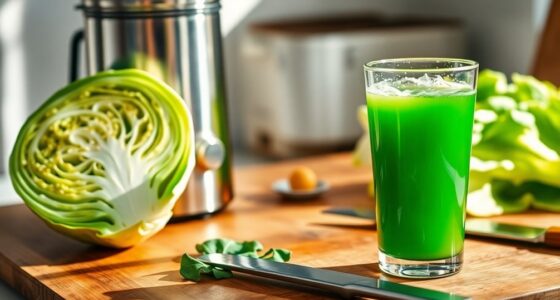A medium-sized navel orange typically yields about 4 to 5 tablespoons of juice, which is roughly 1/4 to 1/3 cup. To make a full cup of juice, you'll need about 3 to 4 oranges. The exact amount can vary depending on the size and ripeness of the oranges you choose. For the best flavor and sweetness in your juice, selecting plump, ripe oranges is key. You might find some tips for maximizing that juice yield interesting!
Key Takeaways
- A medium-sized navel orange yields about 4 to 5 tablespoons of juice, equating to roughly 1/4 to 1/3 cup.
- Generally, 3 to 4 navel oranges are needed to produce a full cup of juice.
- Juice yield varies based on the size and ripeness of the oranges; larger, riper oranges produce more juice.
- Selecting plump, ripe navel oranges enhances juice sweetness and flavor.
- Rolling oranges on a countertop before juicing can help increase juice yield by breaking internal membranes.

When you grab a medium-sized navel orange, you can expect it to yield about 4 to 5 tablespoons of juice, roughly 1/4 to 1/3 cup. This amount of juice makes navel oranges a popular choice for those looking to enjoy fresh juice at home. Their juiciness and natural sweetness create a delightful drink that brightens up your morning or serves as a refreshing treat throughout the day. For those wondering how much juice in navel orange, it’s important to note that the exact yield can vary slightly based on the fruit’s ripeness and juiciness. The vibrant flavor of the juice can also elevate various recipes, adding a zesty kick to dressings, marinades, or desserts. Incorporating navel orange juice into your meals can enhance your culinary experience, making this fruit not just a tasty snack but also a versatile ingredient in the kitchen.
If you're aiming for a full cup of fresh orange juice, you'll need around 3 to 4 navel oranges. This can vary slightly depending on the size and ripeness of the fruits you choose. Larger, riper navel oranges tend to produce more juice, so if you want to maximize the amount of juice you extract, it's worth selecting the plumpest, ripest oranges available.
You'll notice that these ripe fruits not only yield more juice but also enhance the sweetness and flavor of the fresh juice you're preparing. The appeal of navel oranges lies not only in their juiciness but also in their nutritional benefits. With high levels of vitamin C, a cup of fresh orange juice can give your immune system a boost and keep you feeling energized.
This makes navel oranges a great choice for those who want to enjoy a nutritious beverage without relying on store-bought options that might contain added sugars or preservatives. Squeezing your own fresh juice lets you control the ingredients and enjoy the pure, unadulterated flavors of the fruit.
When you cut open a navel orange, you'll often be greeted by vibrant, juicy segments that practically beg to be juiced. The bright color and sweet aroma are indicators of a quality fruit. If you're wondering how to get the most juice from your navel oranges, consider rolling them on the countertop with your palm before cutting. This technique helps to break down some of the internal membranes, leading to a higher yield of juice when you squeeze them.
After you've extracted the juice, you'll appreciate the fresh taste that can't be replicated by anything bottled. Whether you enjoy it straight, mixed with other fruits, or even as a base for cocktails, navel orange juice stands out for its bright flavor profile. The combination of sweetness and tang makes it versatile enough to suit various palates, and it's easy to see why navel oranges are often the go-to choice for juicing.
Frequently Asked Questions
How Many Oranges Make 8 Oz of Juice?
To make 8 ounces of juice, you'll typically need about 4 medium-sized oranges.
Keep in mind that the exact amount can vary based on the size and ripeness of the fruit.
If you want to maximize your yield, try warming the oranges slightly before juicing them.
This simple trick helps release more juice, ensuring you get every last drop for that refreshing drink you're looking to enjoy.
Is Eating an Orange the Same as Drinking Orange Juice?
Eating an orange isn't the same as drinking orange juice. When you eat the whole fruit, you get essential fiber, vitamins, and hydration, which juice lacks.
Juice often has concentrated sugars and fewer nutrients, leading to faster sugar absorption and less satiety. Plus, the fiber in the fruit helps regulate your blood sugar levels better than juice.
Is 2 Cups of Orange Juice a Day Bad?
Drinking 2 cups of orange juice a day can lead to excessive sugar and calorie intake, which mightn't be ideal for your health.
You're likely to exceed the American Heart Association's recommended sugar limits, increasing your risk of weight gain and chronic diseases.
While juice offers some nutrients, you're missing out on the fiber found in whole fruits.
Moderation is essential, so consider limiting your intake to 1 cup daily for a healthier balance.
How Many Tablespoons of Juice Are in a Large Orange?
When you're juicing a large orange, you can expect to get around 4 to 5 tablespoons of juice.
The actual amount might vary based on the orange's size and ripeness, but that's a good estimate. If you've got a particularly juicy one, you might even squeeze out a bit more!
Just remember, navel oranges are known for their sweetness and juiciness, making them a great choice for fresh juice.
Conclusion
When you squeeze a navel orange, you're tapping into a burst of sunshine that can yield about a half cup of juice. That's enough to fill a small swimming pool if you keep juicing! So next time you're craving a refreshing drink, remember how much flavorful juice those vibrant oranges can provide. They're not just a snack; they're a delicious way to hydrate and brighten your day! Enjoy every drop of that citrus goodness!
Cindy thoroughly researches juicing trends, techniques, and recipes to provide readers with practical advice and inspiration. Her writing style is accessible, engaging, and designed to make complex concepts easy to understand. Cindy’s dedication to promoting the advantages of juicing shines through her work, empowering readers to make positive changes in their lives through the simple act of juicing.











